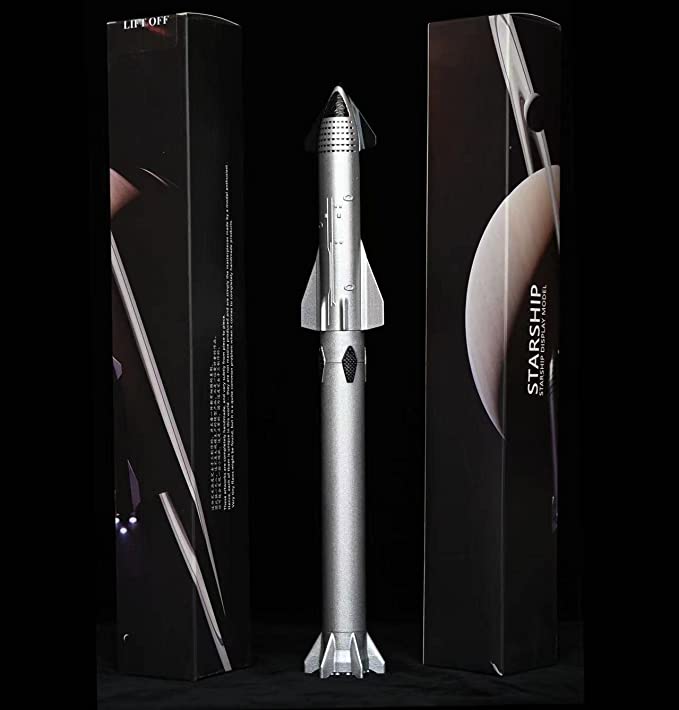SpaceX launches 3 satellites to orbit on 6th-ever Falcon Heavy mission
SpaceX launched its powerful Falcon Heavy rocket for the sixth time ever on Sunday (April 30), sending three satellites to distant geostationary orbit.
The Falcon Heavy lifted off from NASA's Kennedy Space Center in Florida Sunday at 8:26 p.m. EDT (0026 GMT on Monday, May 1), carrying three satellites aloft after days of delay due to weather and a last-minute abort on April 28. SpaceX has not stated the reason for the abort.
Sunday's mission was a long but successful one: The three satellites were deployed as planned over a 13-minute stretch beginning about 4.5 hours after liftoff, SpaceX confirmed via Twitter early Monday morning.
Related: SpaceX's 1st Falcon Heavy rocket launched Elon Musk's Tesla into space

Like giant SpaceX rockets? You can have a Starship of your own with this desktop rocket model. Standing at 12.5 inches (32 cm), this is a 1:375 ratio. See our roundup of awesome Starship gear.
The primary payload on Sunday's mission was ViaSat-3 Americas, a 14,000-pound (6,400 kilograms) broadband satellite that will be operated by California-based company Viasat.
"Viasat-3 is expected to be the world's highest-capacity satellite and will be the largest all-electric satellite ever to be launched," SpaceX propulsion engineer Atticus Vadera said shortly before liftoff during the company's launch webcast.
The second satellite that flew Sunday was Arcturus, a communications craft that will be operated by San Francisco-based Astranis Space Technologies.
Breaking space news, the latest updates on rocket launches, skywatching events and more!
"Although it only weighs 300 kg [660 pounds], the mighty communications satellite has the ability to provide data throughput up to 7.5 Gbps for ... Alaska and the surrounding region," EverydayAstronaut.com wrote of Arcturus in a mission description.
The third payload was GS-1, a cubesat that will be operated by Washington-based Gravity Space. GS-1's primary mission involves providing communications for Internet of Things applications, though it will do some other things in orbit as well.
"The spacecraft is also designed to provide orbital slot reservation services (BIU) around the geosynchronous arc. The spacecraft features three wideband frequency bands," Gravity Space wrote in a description of the satellite. "The spacecraft will also carry an imaging system capable of imaging both the Earth and spatial bodies, as well as an experimental rendezvous and docking payload."
The Falcon Heavy consists of three strapped-together first stages of SpaceX's workhorse Falcon 9 rocket. The central booster is topped with an upper stage and the payload(s).
Falcon Heavy debuted in February 2018 with a memorable test flight flight that sent SpaceX founder and CEO Elon Musk's red Tesla Roadster into orbit around the sun with Starman, a spacesuit-clad mannequin, at the wheel.
The burly rocket has now flown five more times since then, including twice in 2023. This year's other mission, called USSF-67, was a mission for the U.S. Space Force that launched in January.
The Falcon Heavy's three first-stage boosters are designed to be reusable. However, none of the boosters were recovered on Sunday's mission, because they didn't have enough fuel left over to maneuver themselves safely back to Earth for a vertical touchdown after sending such a heavy load to such a distant orbit. (Geostationary orbit lies about 22,200 miles, or 35,700 kilometers, from Earth.)
For more than five years, the Falcon Heavy was SpaceX's most powerful rocket. But the company's gigantic Starship vehicle took that title with its debut liftoff on April 20, a test flight that reached a maximum altitude of 24 miles (39 km) and ended in a commanded explosion high above the Gulf of Mexico for safety's sake.
Starship's 33 first-stage Raptor engines generate 16.7 million pounds of thrust at liftoff, according to SpaceX. That's more than three times more than the Falcon Heavy produces, and nearly twice as much as the second-place vehicle, NASA's Space Launch System megarocket.
Editor's note: This story has been corrected to state that Starship produces 16.7 million pounds (not tons) of thrust at liftoff. This story was updated on April 29 to include SpaceX's new launch target after the Falcon Heavy's 1st abort. It was updated again at 8:50 p.m. EDT on April 30 with news of a successful liftoff, then again at 1:30 a.m. EDT on May 1 with news of satellite deployment.
Mike Wall is the author of "Out There" (Grand Central Publishing, 2018; illustrated by Karl Tate), a book about the search for alien life. Follow him on Twitter @michaeldwall. Follow us on Twitter @Spacedotcom or Facebook.

Michael Wall is a Senior Space Writer with Space.com and joined the team in 2010. He primarily covers exoplanets, spaceflight and military space, but has been known to dabble in the space art beat. His book about the search for alien life, "Out There," was published on Nov. 13, 2018. Before becoming a science writer, Michael worked as a herpetologist and wildlife biologist. He has a Ph.D. in evolutionary biology from the University of Sydney, Australia, a bachelor's degree from the University of Arizona, and a graduate certificate in science writing from the University of California, Santa Cruz. To find out what his latest project is, you can follow Michael on Twitter.

